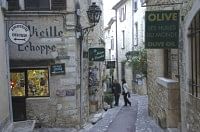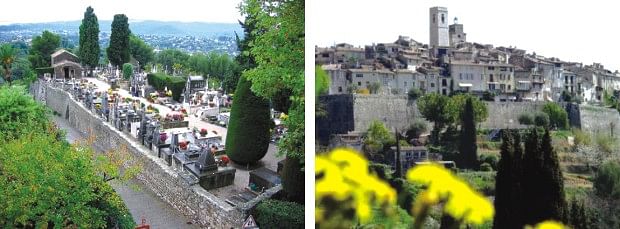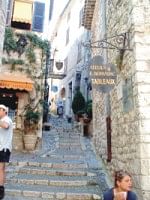| Home - Back Issues - The Team - Contact Us |
 |
| Volume 10 |Issue 17 | April 29, 2011 | |
|
|
A Roman Column A Famous French Village Neeman Sobhan
An alternative title I was toying with, to introduce immediately the name of this fortified medieval Provençal village would be: Tea at Saint Paul de Vence. To rewind just a bit. Half an hour's drive from Cannes and even shorter from Saint Raphael, where we are staying with friends, the Clos des Roses is a wine-producing estate and the closest Côtes de Provence vineyard to the Côte d'Azur. After a long and languid lunch on a sunny terrace at the Bastide du Clos' gastronomique restaurant, we head for the hills. Before long we are standing at the portals of this fortified village dreaming its centuries away like a stone eagle perched on a rocky promontory, high above a valley with the Mediterranean to its south and the Alps to its north. As we stroll down the steep, winding alleys under arches, and narrow, cobbled paths past the beautifully preserved facades of ancient houses, past stylish shop windows and modern art galleries, and look up to the flowers spilling out of overhead balconies, I stop short. This village is stunning, certainly, yet so familiar; it's beauty unsurprising. It almost makes me blurt out: "Oh! Isn't this just like our Montepulciano! And look, that bit, so reminiscent of Pienza or Trequanda…" But I stop myself. I am not in Italy but in the South of France. I wouldn't want my hosts to throw me off the ramparts saying "We bring you all the way to Saint Paul de Vence and all you can say is 'Oh! Isn't it like San Gimignano or Montalcino' or whatever!" But our friends would understand and forgive, because they are well traveled in both Italy and France; and so they know from experience the similarity in the beauty of say, the landscape between the Italian Riviera and the Côte d'Azur. They too, have experienced, the way a bit of Tuscany can suddenly look like Provence with its mix of olive trees, vineyards and undulating fields and hillsides; or the way a coast-hugging motorway above the Mediterranean blue can remind one of the Amalfi coast or Positano even though you have Monte Carlo behind you and Nice ahead.
The French have a word for what I feel, and I may be forgiven by my friend Veronique for coming all the way to Saint Paul de Vence to experience it. Déjà vu! But, of course, this can never be completely true. Beauty, whether of natural landscapes, literature or good food, might have the same ingredients, themes, flavours; yet they may be combined to produce, each time, a subtle or surprising difference making each encounter extraordinary, spectacular, memorable. And so it is here. Even coming from a gem encrusted territory of Italy, rich with scenery and medieval relics, I would have no hesitation in saying that Saint Paul de Vence is a jewel. After I overcome the many physical similarities of this medieval village and others I have seen in Italy, and walk through its serpentine streets looking at the shops and house fronts, I realize that this place can only be French. There is a quality of studied elegance everywhere; a classy, cool glamour even in its earthy provençal decorative style, making it charming yet a bit distant, thus setting it apart from the spontaneous, laid-back warmth of rustic Italian towns and villages. Or it could be that the French language endows everything with a posh-ness, putting the starch into the most everyday situations and objects. The French for asparagus, l'asperge becomes a stalk of utter grace that would brook no aspersions of being just any vegetable, compared to our Italian asparagi with their green succulence already wilting, pronto to be consumed. Or take raspberry. The framboise is meant to be nestled in blankets of crème de vanille, while the lamponi can be imagined still waiting to be plucked. Oh! What was I thinking, comparing Montepulciano to Saint Paul de Vence. In spite of a similar kind of location and architectural richness, the latter was a royal city once and apparently, is the third most visited tourist spot in France!
I read all this in the booklet I bought immediately from a book stall. While the others looked at the shops selling the most exquisite provençal linen or ate a glace (here I have to say that the word 'gelato' is more inviting than the glacial 'glace') I glanced through the tourist information. Rich patrimony of….. including 12th century collegiate church….15th century Chapel of St. Clare….etc. etc. But wait. It also said, the painters Matisse lived here for a time, and Chagall, and a few other artists who, frankly, I am ignorant of. Seeing the light of interest in my eyes, our friends guide us to a special place. We walk towards the village square called Place Charles de Gaulle and the famous Café de la Place. In front of it, on a sandy rectangular patch of earth shaded by plane trees, some locals are playing boules, the French version of bowling in the sand with wooden balls. The scene, we are told, was probably unchanged from the time when famous inhabitants of this village would gather here to play: Chagall, Miró, Matisse, Jacques Prévert the poet, actor Yves Montand who married actress Simone Signoret here, and Marcel Pagnol, the famous novelist, best loved for his childhood memoirs: 'La Gloire de mon père' and ' Le Château de ma mère'. He once said, "Once a game of boules starts, a whole village is born." But it turns out that even more than this local sport, it was the arts, which created the special ambience and history of Saint Paul as a modern haven for artists, writers, celebrities from the 1920's onwards. We are given a taste of that soon.
As we walk past a gate with ivy heavily draped around it, our friends point out the sign hanging above: La Colombe d'Or. The Golden Dove is a famous inn (now an expensive boutique hotel and restaurant) which became legendary as a meeting place for artists and celebrities. We sneak in to pretend to ask about dinner reservations and glance at the Picasso and Matisse originals on the wall. Both had stayed here and paid their bills with their art. Many famous artists and writers who lived and worked in the French Riviera towns down below would also spend time in Saint Paul or wine and dine at the Colombe d'Or. One of these was F.Scott Fitzgerald with his restless wife Zelda. He wrote 'Tender is the Night' about this area. There are stories about them in this restaurant, including an episode involving the famous dancer of the era Isadora Duncan and a jealous Zelda throwing herself down a stone stairwell! Bernard Shaw also visited Saint Paul de Vence, but whether he stopped for a meal at the Colombe d'Or, I don't know. D.H.Lawrence actually died in Saint Paul but I doubt he was in a position to be one of the clients here, since he came to this village (as did Keats to Rome) in the last stages of Tubercolosis. I clear my head of unhappy thoughts, glance quickly at the Leger mural in the garden courtyard before exiting. Strolling the streets, we notice the vast number of art galleries within the short span of the town's main and side alleys. This is indeed an art lover's haven. The Maeght Foundation, a famous Modern Art Museum outside Saint Paul, is filled with an impressive collection of work by contemporary artists. We stop at a Fragonard shop, the famous perfume makers of the region around Grasse, famous for its flower cultivation and perfume-making culture. Now we want a tea or coffee break. Looking for the right place we walk past vine covered stone walls with wild flowers spilling out of cracks in the ancient bricks and dried up fountains. We walk up the Rue Grande past houses with doors decorated with court of arms on one side and the ramparts on the other side, and glimpse the lush countryside in the distance. Arriving at the Porte Sud de Nice we drift to the broad stone terrace from where we can see the cemetery where the artist Marc Chagall is buried. The view is deathless as art. Beyond the cemetery is the glimmering horizon of the sea and Cap d'Antibes, while down below, the red roofed villages, fields and vineyards fall away. We could be floating over the bastions of this postcard pretty mountain village, like figures in some painting of Chagall. We are washed in the light of the hour, the famous and elusive Painter's Light transfiguring us into an impressionistic vision of Monet who painted at Antibes a dove's flight away. We spy a sunny café close to the ramparts of the town, up a flight of stone steps and on a high terrace. At this hour it is almost empty except for a group of laughing friends still lingering under the umbrella over a long past lunch. We settle down for tea and French pastries, determined not to get up for the next hour. Like us and the dawdling group at the next table, the sunlight too is reluctant to leave Saint Paul de Vence. It shifts and plays among the leaves overhead like children on the sands down there somewhere on the Riviera below, where the coast licks the beaches of Saint Maxime or the tucked away residential beach behind our friend's delightful home in Saint Raphael. I want to thank my friends for bringing us here today. But the pastries have arrived and some things like joy in the moment can only be shared and experienced together, and not expressed. Unless one is a writer, a poet, a singer, a dancer, a painter. And that too, they do later. Now is the moment to absorb the hour and the place, without cogitating. We do not talk but become part of everything that makes a place mythic. Later I will give this quiet moment, this enchanting day, this historic town, a caption in my mind, like a painting. Dreamers of Saint Paul at Tea. Or, An Afternoon with a view.
Copyright
(R) thedailystar.net 2011 |
||||||||||



